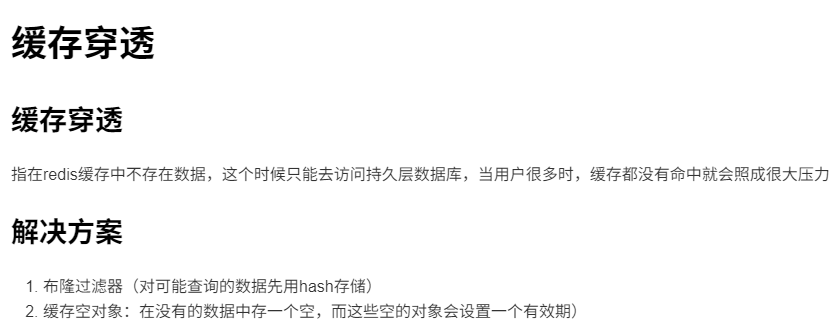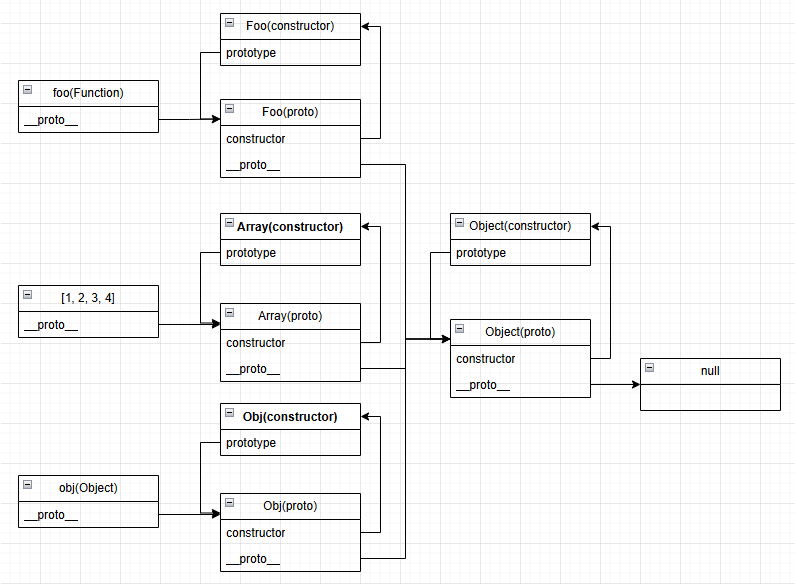缓存穿透 缓存穿透 指在redis缓存中不存在数据,这个时候只能去访问持久层数据库,当用户很多时,缓存都没有命中就会照成很大压力
解决方案
布隆过滤器(对可能查询的数据先用hash存储)
缓存空对象:在没有的数据中存一个空,而这些空的对象会设置一个有效期)
缓存击穿 缓存击穿指的是缓存中没有数据但数据库中有数据(一般是热点数据缓存时间到期),同一时间大量的并发请求由于读缓存没读到数据,就去数据库去取数据,导致某个时间内数据库压力剧增,导致崩溃。
缓存击穿的解决方案
设置热点数据永远不过期(可以判断当前key快要过期时,通过后台异步线程在重新构建缓存)
接口限流与熔断,降级。重要的接口一定要做好限流策略,防止用户恶意刷接口,同时要降级准备,当接口中的某些服务不可用时候,进行熔断,失败快速返回机制。
设置互斥锁。在并发的多个请求中,只有第一个请求线程能拿到锁并执行数据库查询操作,其他的线程拿不到锁就阻塞等着,等到第一个线程将数据写入缓存后,直接走缓存。
就是在缓存失效的时候(判断拿出来的值为空),不是立即去load db。
先使用缓存工具的某些带成功操作返回值的操作(比如Redis的SETNX)去set一个互斥锁。
当操作返回成功时,再进行load db的操作,并回设缓存,最后删除mutex key;
当操作返回失败,证明有线程在load db,当前线程睡眠一段时间再重试整个get缓存的方法。
1 2 3 4 5 6 7 8 9 10 11 12 13 14 15 16 17 18 19 20 21 22 23 24 25 26 27 28 29 30 31 32 33 34 35 36 37 38 39 40 41 42 43 44 45 46 47 48 49 50 51 52 53 54 55 56 57 58 59 60 61 62 63 64 65 66 67 68 69 70 71 72 73 74 75 76 77 78 79 80 81 82 83 84 85 86 87 88 89 90 91 92 93 94 95 96 97 98 99 100 101 102 103 104 105 106 107 108 109 110 111 112 113 114 115 116 117 118 119 120 121 122 123 124 125 126 127 128 129 130 131 132 133 134 135 136 137 138 139 140 141 142 143 144 145 146 147 148 149 150 151 152 153 154 155 156 157 158 159 160 161 162 163 164 165 166 167 168 169 170 171 172 173 174 175 176 177 178 179 180 181 182 183 184 185 186 187 188 189 190 191 192 193 194 195 196 197 198 199 200 201 202 203 204 205 206 207 208 209 210 211 212 213 214 215 216 217 218 219 220 221 222 223 224 225 226 227 228 229 230 231 232 233 234 235 236 237 238 239 240 241 242 243 244 245 246 247 248 249 250 251 252 253 254 255 <?php class Lock private $redis ; private $randomLen = 16 ; private $tolerance = 500 ; private $millisPerSeconds = 1000 ; private $lockCommand = 'if redis.call("GET", KEYS[1]) == ARGV[1] then redis.call("SET", KEYS[1], ARGV[1], "PX", ARGV[2]) return "OK" else return redis.call("SET", KEYS[1], ARGV[1], "NX", "PX", ARGV[2]) end ' ; private $delCommand = 'if redis.call("GET", KEYS[1]) == ARGV[1] then return redis.call("DEL", KEYS[1]) else return 0 end ' ; private $key ; private $id ; private $seconds = 0 ; public function __construct (Redis $redis , string $key ) { $this ->redis = $redis ; $this ->id = $this ->randomUUID (); $this ->key = $key ; } public function randomUUID (string { return substr (uniqid ('' , true ), 5 , $this ->randomLen); } public function getPexpire (int { return $this ->seconds * $this ->millisPerSeconds + $this ->tolerance; } public function acquire (bool { $resp = $this ->redis->eval ($this ->lockCommand, [$this ->key, $this ->id, $this ->getPexpire ()], 1 ); if ($resp == 'OK' ) { return true ; } return false ; } public function release (bool { $resp = $this ->redis->eval ($this ->delCommand, [$this ->key, $this ->id], 1 ); return $resp == 1 ; } public function setExpire (int $expire { $this ->seconds = $expire ; } } $redis = new Redis ();$redis ->connect ('192.168.4.61' , 6379 );$key = 'lock:testtest' ;$lock = new Lock ($redis , $key );$lock ->setExpire (60 );var_dump ($lock ->acquire ());var_dump ($lock ->acquire ());$lock2 = new Lock ($redis , $key );$lock2 ->setExpire (30 );var_dump ($lock2 ->acquire ());<?php class Cache private $redis ; private $rate = 200 ; private $maxLoops = 5 ; public function __construct ($redis { $this ->redis = $redis ; } public function setRate (int $rate { $this ->rate = $rate ; } public function getCache ($key , Closure $fn { for ($i = 0 ; $i < $this ->maxLoops; $i ++) { $value = $this ->redis->get ($key ); if (!empty ($value )) { return $value ; } $lock = new Lock (); if (!$lock ->lock ()) { usleep ($this ->rate * 1000 ); continue ; } $value = $fn (); $this ->redis->set ($key , $value ); $lock ->unlock (); return $value ; } return 0 ; } } class User public function getName ( { return 'jerry' ; } public function getUserById ($userId { $key = 'cache:user_id' . $userId ; $redis = new Redis (); $redis ->connect ('192.168.4.61' , 6379 ); $cache = new Cache ($redis ); $cache ->setRate (300 ); return $cache ->getCache ($key , function () use ($userId ) { // DB return (new User ())->getName (); }); } } $user = new User ();echo $user ->getUserById (1 );
缓存雪崩 缓存雪崩:在某个时间段,缓存集体过期、redis宕机
解决方案 给key的失效时间设置为随机时间,避免集体过期;双缓存;加互斥锁
解决方式
若是由于大量key过期所造成的,可以给key的ttl设置随机时间,避免集体过期
若是因为redis服务器宕机所导致的,可以搭建redis集群,保证高可用
可以从请求量层面进行解决,对缓存业务添加限流和服务降级策略
可以添加多级缓存,比如说nginx缓存
布隆过滤器 我们可以这样考虑,可以先判断key值是否存在,如果不存在,则不访问redis,那这样就可以拦截大量的请求,布隆过滤器恰好可以实现这样的需求。
布隆过滤器本质是一个二进制向量,初始化的时候每一个位置都是0,如下图,比如说a经过hash算法后得到一个下标位置,接下来就会把下标的值改为1,图中所示的是每一个元素经过三次hash运算,每一个红线代表一次hash算法,为什么要运算三次呢,这是为了减少hash冲突,当然hash算法不一定是三次,经过多次不同维度的哈市算法后,就把a值映射到了二进制向量里面,这样的好处很多,可以节省空间,假如说a值是一串很长的字符串,那么经过映射后就可以只占三位长度,并且查找速度很快。
如果布隆过滤器判断元素存在,则不一定存在,如果不存在,则一定不存在
布隆过滤器的使用 注意的是布隆过滤器有一定的误判率,不可能达到100%的精准,首先初始化项目的时候从数据库查询出来所有的key值,然后放到布隆过滤器中。
实现代码 1 2 3 4 5 6 7 8 9 10 11 12 13 14 15 16 17 18 19 20 21 22 23 24 25 26 27 28 29 30 31 32 33 34 35 36 37 38 39 40 41 42 43 44 45 46 47 48 49 50 51 52 53 54 55 56 57 58 59 60 61 62 63 64 65 66 67 68 69 70 71 72 73 74 75 76 77 78 79 80 81 82 83 84 85 86 87 88 89 90 91 92 93 94 95 96 97 98 99 100 101 102 103 104 105 106 107 108 109 110 111 112 113 114 115 116 117 118 119 120 121 122 123 124 125 126 127 128 129 130 131 132 133 134 135 136 137 138 139 140 141 142 143 144 145 146 147 148 149 <?php Class Bloom { private $maps = 14 ; private $bits = 20000 ; private $setScript = ' for _, offset in ipairs(ARGV) do redis.call("setbit", KEYS[1], offset, 1) end return true ' ; private $testScript = ' for _, offset in ipairs(ARGV) do if tonumber(redis.call("getbit", KEYS[1], offset)) == 0 then return false end end return true ' ; private $key ; private $redis ; public function __construct ($redis , $key { $this ->redis = $redis ; $this ->key = $key ; } private function buildOffsetArgs (array $offsets array { array_unshift ($offsets , $this ->key); return $offsets ; } private function set (array $offsets bool { return $this ->redis->eval ($this ->setScript, $this ->buildOffsetArgs ($offsets ), 1 ); } private function check (array $offsets bool { return $this ->redis->eval ($this ->testScript, $this ->buildOffsetArgs ($offsets ), 1 ); } private function getLocations (string $data array { $locations = []; for ($i = 0 ; $i < $this ->maps; $i ++) { $data .= (string ) $i ; $hashValue = crc32 ($data ); $locations [$i ] = $hashValue % $this ->bits; } return $locations ; } public function add (string $data { $locations = $this ->getLocations ($data ); return $this ->set ($locations ); } public function exists (string $data bool { $locations = $this ->getLocations ($data ); return $this ->check ($locations ); } public function expire (int $second bool { return $this ->redis->expire ($this ->key, $second ); } } $redis = new Redis ();$redis ->connect ('192.168.4.61' , 6379 );$bloomKey = 'bloom:test' ;$data = 'helloworld2' ;$bloom = new Bloom ($redis , $bloomKey );var_dump ($bloom ->exists ($data ));
加了布隆过滤器的过程如下
当应用访问的时候,先去布隆过滤器中判断kedy值,如果发觉没有key值不存在,直接返回
如果key值在布隆过滤器存在,则去访问redis,由于是有误判率的,所以redis也有可能不存在
那么这时候就去访问数据库,数据库不存在,那就直接返回空就行
如果误判率为3%,当有100万个请求同时过来的时候,布隆过滤器已经挡住了97万个请求,剩下3万个请求假如是误判的,这时候再访问数据库可以通过加锁的方式实现,只有竞争到锁了就去访问数据库,这样就完全可以解决缓存穿透问题
布隆过滤器的应用 比如说输入用户名的时候,可以马上检测出该用户名是否存在,黑名单机制,单词错误检测等
Rainbow Bubbles
I have seen through it, but not to the end.





